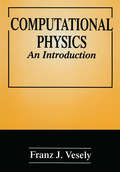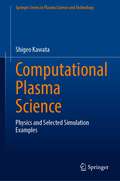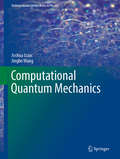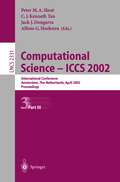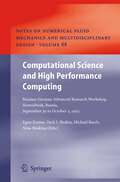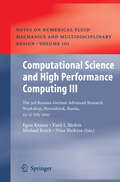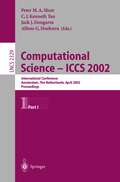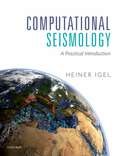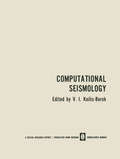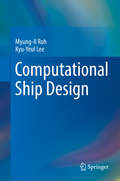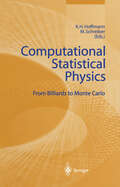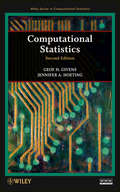- Table View
- List View
Computational Physics: Problem Solving with Python
by Rubin H. Landau Manuel J Páez Cristian C. BordeianuThe use of computation and simulation has become an essential part of the scientific process. Being able to transform a theory into an algorithm requires significant theoretical insight, detailed physical and mathematical understanding, and a working level of competency in programming. This upper-division text provides an unusually broad survey of the topics of modern computational physics from a multidisciplinary, computational science point of view. Its philosophy is rooted in learning by doing (assisted by many model programs), with new scientific materials as well as with the Python programming language. Python has become very popular, particularly for physics education and large scientific projects. It is probably the easiest programming language to learn for beginners, yet is also used for mainstream scientific computing, and has packages for excellent graphics and even symbolic manipulations. The text is designed for an upper-level undergraduate or beginning graduate course and provides the reader with the essential knowledge to understand computational tools and mathematical methods well enough to be successful. As part of the teaching of using computers to solve scientific problems, the reader is encouraged to work through a sample problem stated at the beginning of each chapter or unit, which involves studying the text, writing, debugging and running programs, visualizing the results, and the expressing in words what has been done and what can be concluded. Then there are exercises and problems at the end of each chapter for the reader to work on their own (with model programs given for that purpose).
Computational Physics: Problem Solving with Python
by Rubin H. Landau Manuel J Páez Cristian C. BordeianuThe use of computation and simulation has become an essential part of the scientific process. Being able to transform a theory into an algorithm requires significant theoretical insight, detailed physical and mathematical understanding, and a working level of competency in programming. This upper-division text provides an unusually broad survey of the topics of modern computational physics from a multidisciplinary, computational science point of view. Its philosophy is rooted in learning by doing (assisted by many model programs), with new scientific materials as well as with the Python programming language. Python has become very popular, particularly for physics education and large scientific projects. It is probably the easiest programming language to learn for beginners, yet is also used for mainstream scientific computing, and has packages for excellent graphics and even symbolic manipulations. The text is designed for an upper-level undergraduate or beginning graduate course and provides the reader with the essential knowledge to understand computational tools and mathematical methods well enough to be successful. As part of the teaching of using computers to solve scientific problems, the reader is encouraged to work through a sample problem stated at the beginning of each chapter or unit, which involves studying the text, writing, debugging and running programs, visualizing the results, and the expressing in words what has been done and what can be concluded. Then there are exercises and problems at the end of each chapter for the reader to work on their own (with model programs given for that purpose).
Computational Physics: Problem Solving with Python
by Rubin H. Landau Manuel J. Páez Cristian C. BordeianuComputational Physics The classic in the field for more than 25 years, now with increased emphasis on data science and new chapters on quantum computing, machine learning (AI), and general relativity Computational physics combines physics, applied mathematics, and computer science in a cutting-edge multidisciplinary approach to solving realistic physical problems. It has become integral to modern physics research because of its capacity to bridge the gap between mathematical theory and real-world system behavior. Computational Physics provides the reader with the essential knowledge to understand computational tools and mathematical methods well enough to be successful. Its philosophy is rooted in “learning by doing”, assisted by many sample programs in the popular Python programming language. The first third of the book lays the fundamentals of scientific computing, including programming basics, stable algorithms for differentiation and integration, and matrix computing. The latter two-thirds of the textbook cover more advanced topics such linear and nonlinear differential equations, chaos and fractals, Fourier analysis, nonlinear dynamics, and finite difference and finite elements methods. A particular focus in on the applications of these methods for solving realistic physical problems. Readers of the fourth edition of Computational Physics will also find: An exceptionally broad range of topics, from simple matrix manipulations to intricate computations in nonlinear dynamicsA whole suite of supplementary material: Python programs, Jupyter notebooks and videos Computational Physics is ideal for students in physics, engineering, materials science, and any subjects drawing on applied physics.
Computational Physics: Problem Solving with Python
by Rubin H. Landau Manuel J. Páez Cristian C. BordeianuComputational Physics The classic in the field for more than 25 years, now with increased emphasis on data science and new chapters on quantum computing, machine learning (AI), and general relativity Computational physics combines physics, applied mathematics, and computer science in a cutting-edge multidisciplinary approach to solving realistic physical problems. It has become integral to modern physics research because of its capacity to bridge the gap between mathematical theory and real-world system behavior. Computational Physics provides the reader with the essential knowledge to understand computational tools and mathematical methods well enough to be successful. Its philosophy is rooted in “learning by doing”, assisted by many sample programs in the popular Python programming language. The first third of the book lays the fundamentals of scientific computing, including programming basics, stable algorithms for differentiation and integration, and matrix computing. The latter two-thirds of the textbook cover more advanced topics such linear and nonlinear differential equations, chaos and fractals, Fourier analysis, nonlinear dynamics, and finite difference and finite elements methods. A particular focus in on the applications of these methods for solving realistic physical problems. Readers of the fourth edition of Computational Physics will also find: An exceptionally broad range of topics, from simple matrix manipulations to intricate computations in nonlinear dynamicsA whole suite of supplementary material: Python programs, Jupyter notebooks and videos Computational Physics is ideal for students in physics, engineering, materials science, and any subjects drawing on applied physics.
Computational Physics: Simulation of Classical and Quantum Systems (Graduate Texts in Physics)
by Philipp O.J. SchererThis textbook presents basic numerical methods and applies them to a large variety of physical models in multiple computer experiments. Classical algorithms and more recent methods are explained. Partial differential equations are treated generally comparing important methods, and equations of motion are solved by a large number of simple as well as more sophisticated methods. Several modern algorithms for quantum wavepacket motion are compared. The first part of the book discusses the basic numerical methods, while the second part simulates classical and quantum systems. Simple but non-trivial examples from a broad range of physical topics offer readers insights into the numerical treatment but also the simulated problems. Rotational motion is studied in detail, as are simple quantum systems. A two-level system in an external field demonstrates elementary principles from quantum optics and simulation of a quantum bit. Principles of molecular dynamics are shown. Modern boundary element methods are presented in addition to standard methods, and waves and diffusion processes are simulated comparing the stability and efficiency of different methods. A large number of computer experiments is provided, which can be tried out even by readers with no programming skills. Exercises in the applets complete the pedagogical treatment in the book. In the third edition Monte Carlo methods and random number generation have been updated taking recent developments into account. Krylov-space methods for eigenvalue problems are discussed in much more detail. Short time Fourier transformation and wavelet transformation have been included as tools for time-frequency analysis. Lastly, elementary quantum many-body problems demonstrate the application of variational and Monte-Carlo methods.
Computational Physics: Simulation of Classical and Quantum Systems (Graduate Texts in Physics)
by Philipp SchererThis textbook presents basic and advanced computational physics in a very didactic style. It contains very-well-presented and simple mathematical descriptions of many of the most important algorithms used in computational physics. The first part of the book discusses the basic numerical methods. The second part concentrates on simulation of classical and quantum systems. Several classes of integration methods are discussed including not only the standard Euler and Runge Kutta method but also multi-step methods and the class of Verlet methods, which is introduced by studying the motion in Liouville space. A general chapter on the numerical treatment of differential equations provides methods of finite differences, finite volumes, finite elements and boundary elements together with spectral methods and weighted residual based methods. The book gives simple but non trivial examples from a broad range of physical topics trying to give the reader insight into not only the numerical treatment but also simulated problems. Different methods are compared with regard to their stability and efficiency. The exercises in the book are realised as computer experiments.
Computational Physics: Simulation of Classical and Quantum Systems
by Philipp O.J. SchererThis book encapsulates the coverage for a two-semester course in computational physics. The first part introduces the basic numerical methods while omitting mathematical proofs but demonstrating the algorithms by way of numerous computer experiments. The second part specializes in simulation of classical and quantum systems with instructive examples spanning many fields in physics, from a classical rotor to a quantum bit. All program examples are realized as Java applets ready to run in your browser and do not require any programming skills.
Computational Physics: Selected Methods Simple Exercises Serious Applications
by Michael Schreiber Karl H HoffmannComputational Physics. Selected Methods, Simple Exercises, Serious Applications is an overview written by leading researchers of a variety of fields and developments. Selected Methods introduce the reader to current fields, including molecular dynamics, hybrid Monte-Carlo algorithms, and neural networks. Simple Exercises give hands-on advice for effective program solutions from a small number of lines to demonstration programs with elaborate graphics. Serious Applications show how questions concerning, for example, aging, many-minima optimisation, or phase transitions can be treated by appropriate tools. The source code and demonstration graphics are included on a 3.5" MS-DOS diskette.
Computational Physics: An Introduction
by Franz J. VeselyAuthor Franz J. Vesely offers students an introductory text on computational physics, providing them with the important basic numerical/computational techniques. His unique text sets itself apart from others by focusing on specific problems of computational physics. The author also provides a selection of modern fields of research. Students will benefit from the appendixes which offer a short description of some properties of computing and machines and outline the technique of 'Fast Fourier Transformation.'
Computational Physics: An Introduction
by Franz J. VeselyIn a rapidly evolving field such as computational physics, six years is an eternity. Even though many of the elementary techniques described here are of venerable age, their assembly into sophisticated combined methods and their intensive application to ever new problems is an ongoing and exciting process. After six years, a new the new vistas edition of this textbook must therefore take into account some of that have opened up recently. Apart from these additions and some didactic improvements, the general struc ture of the book holds good. The first three chapters are devoted to a thorough, if concise, treatment of the main ingredients from numerical mathematics: finite differences, linear algebra, and stochastics. This exercise will prove valuable when we proceed, in chapters 4 and 5, to combine these elementary tools into powerful instruments for the integration of differential equations. The final chapters are devoted to a number of applications in selected fields: statistical physics, quantum mechanics, and hydrodynamics. I will gradually augment this text by web-resident sample programs. These will be written in JAVA and will be accompanied by short explanations and references to this text. Thus it may prove worthwhile to pay an occasional visit to my web-site www.ap.univie.ac.at/users/Franz.Vesely/ to see if any new applets have sprung up.
Computational Plasma Science: Physics and Selected Simulation Examples (Springer Series in Plasma Science and Technology)
by Shigeo KawataThe book presents fundamentals of plasma physics with rich references and computational techniques in a concise manner. It particularly focuses on introductions to numerical simulation methods in plasma physics, in addition to those to physics and mathematics in plasma physics. It also presents the fundamentals of numerical methods, which solve mathematical models of plasmas, together with examples of numerical results. A discretization method, the so-called finite difference method, is introduced for particle-in-cell methods and fluid codes, which have been widely employed in plasma physics studies. In addition to the introduction to numerical solutions, it also covers numerical stability. The instabilities and numerical errors significantly influence the results, and for correct results, great efforts are required to avoid such numerical artifacts. The book also carefully discusses the numerical errors, numerical stability, and uncertainty in numerical computations. Readers are expected to have an understanding of fundamental physics of mechanics, electromagnetism, thermodynamics, statistical physics, relativity, fluid dynamics, and mathematics, but the book does not assume background knowledge on plasma. Therefore, it is a first book of plasma physics for upper undergraduate and early graduate students who are interested in learning it.
Computational Problems in Engineering (Lecture Notes in Electrical Engineering #307)
by Nikos Mastorakis Valeri MladenovThis book provides readers with modern computational techniques for solving variety of problems from electrical, mechanical, civil and chemical engineering. Mathematical methods are presented in a unified manner, so they can be applied consistently to problems in applied electromagnetics, strength of materials, fluid mechanics, heat and mass transfer, environmental engineering, biomedical engineering, signal processing, automatic control and more.
Computational Quantum Mechanics (Undergraduate Lecture Notes in Physics)
by Joshua Izaac Jingbo WangQuantum mechanics undergraduate courses mostly focus on systems with known analytical solutions; the finite well, simple Harmonic, and spherical potentials. However, most problems in quantum mechanics cannot be solved analytically. This textbook introduces the numerical techniques required to tackle problems in quantum mechanics, providing numerous examples en route. No programming knowledge is required – an introduction to both Fortran and Python is included, with code examples throughout. With a hands-on approach, numerical techniques covered in this book include differentiation and integration, ordinary and differential equations, linear algebra, and the Fourier transform. By completion of this book, the reader will be armed to solve the Schrödinger equation for arbitrarily complex potentials, and for single and multi-electron systems.
Computational Science — ICCS 2002: International Conference Amsterdam, The Netherlands, April 21–24, 2002 Proceedings, Part III (Lecture Notes in Computer Science #2331)
by Peter M. A. Sloot C. J. Kenneth Tan Jack J. Dongarra Alfons G. HoekstraComputational Science is the scientific discipline that aims at the development and understanding of new computational methods and techniques to model and simulate complex systems. The area of application includes natural systems - such as biology environ mental and geo-sciences, physics, and chemistry - and synthetic systems such as electronics and financial and economic systems. The discipline is a bridge bet ween 'classical' computer science - logic, complexity, architecture, algorithm- mathematics, and the use of computers in the aforementioned areas. The relevance for society stems from the numerous challenges that exist in the various science and engineering disciplines, which can be tackled by advances made in this field. For instance new models and methods to study environmental issues like the quality of air, water, and soil, and weather and climate predictions through simulations, as well as the simulation-supported development of cars, airplanes, and medical and transport systems etc. Paraphrasing R. Kenway (R.D. Kenway, Contemporary Physics. 1994): 'There is an important message to scientists, politicians, and industrialists: in the future science, the best industrial design and manufacture, the greatest medical progress, and the most accurate environmental monitoring and forecasting will be done by countries that most rapidly exploit the full potential of computational science'. Nowadays we have access to high-end computer architectures and a large range of computing environments, mainly as a consequence of the enormous sti mulus from the various international programs on advanced computing, e.g.
Computational Science — ICCS 2002: International Conference Amsterdam, The Netherlands, April 21–24, 2002 Proceedings, Part II (Lecture Notes in Computer Science #2330)
by Peter M. A. Sloot C. J. Kenneth Tan Jack J. Dongarra Alfons G. HoekstraComputational Science is the scienti?c discipline that aims at the development and understanding of new computational methods and techniques to model and simulate complex systems. The area of application includes natural systems – such as biology, envir- mental and geo-sciences, physics, and chemistry – and synthetic systems such as electronics and ?nancial and economic systems. The discipline is a bridge b- ween ‘classical’ computer science – logic, complexity, architecture, algorithms – mathematics, and the use of computers in the aforementioned areas. The relevance for society stems from the numerous challenges that exist in the various science and engineering disciplines, which can be tackled by advances made in this ?eld. For instance new models and methods to study environmental issues like the quality of air, water, and soil, and weather and climate predictions through simulations, as well as the simulation-supported development of cars, airplanes, and medical and transport systems etc. Paraphrasing R. Kenway (R.D. Kenway, Contemporary Physics. 1994): ‘There is an important message to scientists, politicians, and industrialists: in the future science, the best industrial design and manufacture, the greatest medical progress, and the most accurate environmental monitoring and forecasting will be done by countries that most rapidly exploit the full potential ofcomputational science’. Nowadays we have access to high-end computer architectures and a large range of computing environments, mainly as a consequence of the enormous s- mulus from the various international programs on advanced computing, e.g.
Computational Science and High Performance Computing: Russian-German Advanced Research Workshop, Novosibirsk, Russia, September 30 to October 2, 2003 (Notes on Numerical Fluid Mechanics and Multidisciplinary Design #88)
by Egon Krause Yurii I. Shokin Nina ShokinaThisvolumeispublishedastheproceedingsoftheRussian-GermanAdvanced Research workshop on Computational Science and High Performance C- puting in Novosibirsk Academgorodok in September 2003. The contributions of these proceedings were provided and edited by the authors, chosen after a careful selection and reviewing. The workshop was organized by the Institute of Computational Techno- gies SB RAS (Novosibirsk, Russia) and the High Performance Computing Center Stuttgart (Stuttgart, Germany). The objective was the discussion of the latest results in computational science and to develop a close coope- tion between Russian and German specialists in the above-mentioned ?eld. The main directions of the workshop are associated with the problems of computational hydrodynamics, application of mathematical methods to the development of new generation of materials, environment protection pr- lems, development of algorithms, software and hardware support for hi- performance computation, and designing modern facilities for visualization of computational modelling results. The importance of the workshop topics was con?rmed by the partici- tion of representatives of major research organizations engaged in the so- tion of the most complex problems of mathematical modelling, development of new algorithms, programs and key elements of new information techno- gies. Among the Russian participants were researchers of the Institutes of the Siberian Branch of the Russian Academy of Sciences: Institute of Com- tational Technologies, Institute of Computational Mathematics and Mat- matical Geophysics, Institute of Computational Modelling, Russian Federal Nuclear Center, All-Russian Research Institute of Experimental Physics, - merovo State University.
Computational Science and High Performance Computing II: The 2nd Russian-German Advanced Research Workshop, Stuttgart, Germany, March 14 to 16, 2005 (Notes on Numerical Fluid Mechanics and Multidisciplinary Design #91)
by Egon Krause Yurii I. Shokin Nina ShokinaThis volume contains 27 contributions to the Second Russian-German Advanced Research Workshop on Computational Science and High Performance Computing presented in March 2005 at Stuttgart, Germany. Contributions range from computer science, mathematics and high performance computing to applications in mechanical and aerospace engineering.
Computational Science and High Performance Computing III: The 3rd Russian-German Advanced Research Workshop, Novosibirsk, Russia, 23 - 27 July 2007 (Notes on Numerical Fluid Mechanics and Multidisciplinary Design #101)
by Egon Krause Yurii I. Shokin Nina ShokinaComputational Science - ICCS 2002: International Conference, Amsterdam, The Netherlands, April 21-24, 2002. Proceedings, Part I (Lecture Notes in Computer Science #2329)
by Peter M. A. Sloot C. J. Kenneth Tan Jack J. Dongarra Alfons G. HoekstraComputational Science is the scienti?c discipline that aims at the development and understanding of new computational methods and techniques to model and simulate complex systems. The area of application includes natural systems – such as biology, envir- mental and geo-sciences, physics, and chemistry – and synthetic systems such as electronics and ?nancial and economic systems. The discipline is a bridge b- ween ‘classical’ computer science – logic, complexity, architecture, algorithms – mathematics, and the use of computers in the aforementioned areas. The relevance for society stems from the numerous challenges that exist in the various science and engineering disciplines, which can be tackled by advances made in this ?eld. For instance new models and methods to study environmental issues like the quality of air, water, and soil, and weather and climate predictions through simulations, as well as the simulation-supported development of cars, airplanes, and medical and transport systems etc. Paraphrasing R. Kenway (R.D. Kenway, Contemporary Physics. 1994): ‘There is an important message to scientists, politicians, and industrialists: in the future science, the best industrial design and manufacture, the greatest medical progress, and the most accurate environmental monitoring and forecasting will be done by countries that most rapidly exploit the full potential ofcomputational science’. Nowadays we have access to high-end computer architectures and a large range of computing environments, mainly as a consequence of the enormous s- mulus from the various international programs on advanced computing, e.g.
Computational Seismology: A Practical Introduction
by Heiner IgelThis book is an introductory text to a range of numerical methods used today to simulate time-dependent processes in Earth science, physics, engineering, and many other fields. The physical problem of elastic wave propagation in 1D serves as a model system with which the various numerical methods are introduced and compared. The theoretical background is presented with substantial graphical material supporting the concepts. The results can be reproduced with the supplementary electronic material provided as python codes embedded in Jupyter notebooks. The book starts with a primer on the physics of elastic wave propagation, and a chapter on the fundamentals of parallel programming, computational grids, mesh generation, and hardware models. The core of the book is the presentation of numerical solutions of the wave equation with six different methods: 1) the finite-difference method; 2) the pseudospectral method (Fourier and Chebyshev); 3) the linear finite-element method; 4) the spectral-element method; 5) the finite-volume method; and 6) the discontinuous Galerkin method. Each chapter contains comprehension questions, theoretical, and programming exercises. The book closes with a discussion of domains of application and criteria for the choice of a specific numerical method, and the presentation of current challenges.
Computational Seismology
by V. I. Keilis-Boroksense do not grow as fast as computational possi This book contains selections from Volumes bilities. I-V of the series "Computational Seismology," which Moreover, for some strange reason, comput was initiated a few years ago by the Academy of ers usually create a spirit of haste, though they are Sciences of the USSR. Volume V was still in prepa intended to provide time for meditation. In com ration when the translation was begun, and the trans puterizing seismology, therefore, one must first lations of papers from it were made from manu generalize the methods and then make them more scripts. Most of the authors are members of the rigorous mathematically. All relevant data must Department of Computational Geophysics of the In be processed jointly. Insofar as is possible, a priori stitute of Physics of the Earth, Moscow. hypotheses should be avoided. Particular attention The series is dedicated to theoretical and must be given to exact formulation of the problem, computational aspects of the analysis of seismolog to questions of uniqueness and stability, to the con ical data. The present state of this field is typical fidence limits of the results, etc. This general ap of our times. The rapidly increasing flow of infor proach is required in solving the main problems of mation is already too vast to be processed or even modern seismology, which are by definition general comprehended in a traditional way. This has forced problems. This approach has other advantages.
Computational Ship Design (Springer Series On Naval Architecture, Marine Engineering, Shipbuilding And Shipping Ser. #4)
by Myung-Il Roh Kyu-Yeul LeeThis book offers an introduction to the fundamental principles and systematic methodologies employed in computational approaches to ship design. It takes a detailed approach to the description of the problem definition, related theories, mathematical formulation, algorithm selection, and other core design information. Over eight chapters and appendices the book covers the complete process of ship design, from a detailed description of design theories through to cutting-edge applications. Following an introduction to relevant terminology, the first chapters consider ship design equations and models, freeboard calculations, resistance prediction and power estimation. Subsequent chapters cover topics including propeller deign, engine selection, hull form design, structural design and outfitting. The book concludes with two chapters considering operating design and economic factors including construction costs and fuel consumption. The book reflects first-hand experiences in ship design and R&D activities, and incorporates improvements based on feedback received from many industry experts. Examples provided are based on genuine case studies in the field. The comprehensive description of each design stage presented in this book offers guidelines for academics, researchers, students, and industrial manufactures from diverse fields, including ocean engineering and mechanical engineering. From a commercial point of view the book will be of great value to those involved in designing a new vessel or improving an existing ship.
Computational Statistical Physics: From Billiards to Monte Carlo
by K. H Hoffmann Michael SchreiberIn recent years statistical physics has made significant progress as a result of advances in numerical techniques. While good textbooks exist on the general aspects of statistical physics, the numerical methods and the new developments based on large-scale computing are not usually adequately presented. In this book 16 experts describe the application of methods of statistical physics to various areas in physics such as disordered materials, quasicrystals, semiconductors, and also to other areas beyond physics, such as financial markets, game theory, evolution, and traffic planning, in which statistical physics has recently become significant. In this way the universality of the underlying concepts and methods such as fractals, random matrix theory, time series, neural networks, evolutionary algorithms, becomes clear. The topics are covered by introductory, tutorial presentations.
Computational Statistics (Wiley Series in Computational Statistics #710)
by Geof H. Givens Jennifer A. HoetingThis new edition continues to serve as a comprehensive guide to modern and classical methods of statistical computing. The book is comprised of four main parts spanning the field: Optimization Integration and Simulation Bootstrapping Density Estimation and Smoothing Within these sections,each chapter includes a comprehensive introduction and step-by-step implementation summaries to accompany the explanations of key methods. The new edition includes updated coverage and existing topics as well as new topics such as adaptive MCMC and bootstrapping for correlated data. The book website now includes comprehensive R code for the entire book. There are extensive exercises, real examples, and helpful insights about how to use the methods in practice.
Computational Statistics (Wiley Series in Computational Statistics #708)
by Geof H. Givens Jennifer A. HoetingThis new edition continues to serve as a comprehensive guide to modern and classical methods of statistical computing. The book is comprised of four main parts spanning the field: Optimization Integration and Simulation Bootstrapping Density Estimation and Smoothing Within these sections,each chapter includes a comprehensive introduction and step-by-step implementation summaries to accompany the explanations of key methods. The new edition includes updated coverage and existing topics as well as new topics such as adaptive MCMC and bootstrapping for correlated data. The book website now includes comprehensive R code for the entire book. There are extensive exercises, real examples, and helpful insights about how to use the methods in practice.






